Content
- 1 The history of the appearance of miniature roses
- 2 Advantages of miniature roses
- 3 The success of growing miniature roses
- 4 Application in the country
- 5 The best varieties of miniature roses
- 5.1 Miniature rose 'Baby Bunting' variety
- 5.2 Miniature rose cultivar 'Bigoudi'
- 5.3 Miniature rose cultivar 'Cinderella'
- 5.4 Miniature rose cultivar 'Colibri'
- 5.5 Miniature rose ‘Green Ice’
- 5.6 Miniature rose cultivar ‘Daniela’
- 5.7 Miniature rose ‘Fresh Pink’
- 5.8 Miniature rose ‘Gold Symphonie’
- 5.9 Miniature rose cultivar 'Lavender Meillandina'
- 5.10 Miniature rose cultivar 'Maidy'
- 5.11 Miniature rose cultivar 'Mandarine Symphonie'
- 5.12 Miniature rose cultivar ‘Mr. Bluebird '
- 5.13 Miniature rose cultivar 'Rouletii'
- 5.14 Miniature rose cultivar 'Stars'n Stripes'
- 5.15 Miniature rose ‘Sunmaid’
- 5.16 Miniature rose variety 'Pomegranate Bracelet'
- 5.17 Miniature rose variety 'Boy-with-Finger'
- 5.18 Miniature rose cultivar 'Zwergkonigin'
- 6 The best varieties of miniature roses, photo
- 7 Miniature roses for outdoor cultivation
- 8 The best varieties of miniature roses and their photos
- 9 Correct pruning of miniature roses for the winter (with video)
Today, more and more often in the most ceremonial places of summer cottages, you can find miniature roses in containers, pots. They were successfully bred in indoor conditions, where they bloom tirelessly throughout the year.

The history of the appearance of miniature roses
The history of their origin goes back to the 19th century, when dwarf tea roses were brought from China to Europe in 1810. The first official information about them as a dwarf ever-flowering rose (Rosa semperflorens minima) appeared in print in 1815. Then the Laurenz rose (Rosa Lawrenceana), the Indian rose (Rosa indica) appeared in Switzerland, and the famous variety was created on their basis 'Rouletii' - the founder of the first modern varieties of miniature roses.
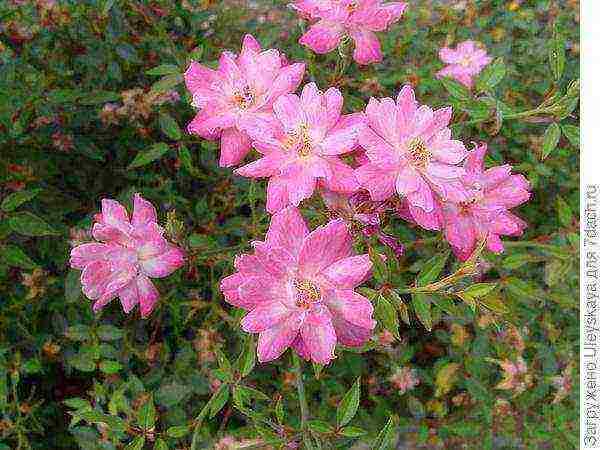
Naturally, European breeders have never seen anything like this before. Crossing the first varieties with low polyanthus and other roses, they got smaller copies of garden roses, which they combined into a separate group of miniature roses.
Advantages of miniature roses
- in dwarfs from 5 to 30 (45) cm in height, unlike ground cover roses at the same height, the shoots do not fall down in an arc and do not spread over the ground for several meters;
- they are densely leafy, their crowns consist of small, often shiny leaves;
- often abundantly decorated with small fragrant flowers of a wide variety of colors: red, orange, yellow, pink, white, two-color, green, purple;
- there are varieties in which the color changes as the flower ages from lemon yellow to cherry red;
- most often 3-15 flowers are collected in compact inflorescences;
- there are terry varieties;
- their flowering lasts from May until frost, and has 3 waves: spring, summer and autumn.
The success of growing miniature roses
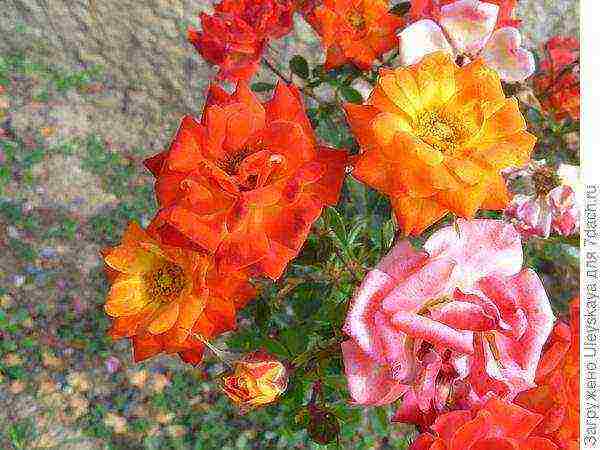
- they are easily propagated by cuttings;
- in central Russia, they winter easily covered with spruce branches and covered with snow;
- if the shoots freeze over in severe snowless winters, then they are removed during spring pruning and this does not affect the abundance of flowering next year;
- in the southern zone of horticulture, as a rule, miniature roses winter covered with snow;
- they are resistant to pests and fungal diseases.
Application in the country
Miniature roses are good in borders, flower beds, rockeries, when decorating balconies, in containers, and in pot culture. They are used for grafting on boles, in a cut for boutonnieres.
The best varieties of miniature roses
Today miniature roses are a self-sufficient garden group of 5,000 varieties. Let's get acquainted with the best of them that can now be seen in Crimea.
Miniature rose 'Baby Bunting' variety

An old variety, created in the Netherlands in 1953. The bush is not compact, up to 35 cm high. Flowers up to 4.5 cm in diameter, carmine-red with a pink center, semi-double, slightly aromatic; bloom from May to autumn.Medium-strong resistance to fungal diseases.
Application A good variety for curbs, ridges, container culture. Will be beautiful in the foreground of mixborders.
Miniature rose cultivar 'Bigoudi'

The ‘Bigoudi’ variety was created by the French company Meilland in 2001. The bushes are up to 45 cm high. The leaves are green, shiny. The flowers are small, up to 5 cm in diameter, red with yellow strokes, double, slightly fragrant, collected in inflorescences. Blooming remontant (repeated), prolonged (long-lasting), begins in June.
Application A variety for an amateur, since some growers do not like such variegation of petals at all. But it will be clearly loved by children who will appreciate both its small size and cheerful coloring. Suitable for groups, curbs, boles and potting. The variety is quite frost-resistant in the southern zone of horticulture, but is weak against fungal diseases: it is strongly affected by black spot, moderately resistant to powdery mildew.
Miniature rose cultivar 'Cinderella'

An old variety. Bushes up to 30-40 cm high and 20 cm wide, compact, shoots without thorns. Flowers up to 3 cm in diameter, white, often turning pink when cold, with a spicy aroma; in inflorescences 5-20 flowers. Abundant and long flowering from early summer. Moderately resistant to powdery mildew and not resistant to black spot.
Application Good in rockeries, borders, containers. The absence of thorns makes this variety suitable for use in the children's area of the summer cottage.
Miniature rose cultivar 'Colibri'

Such varieties are said to be historical. The ‘Colibri’ variety was created by the French firm Meilland in 1958. 20 years later the breeders of the same firm improved it, and the rare apricot-orange color of the rose petals became even more intense. Bushes up to 25 cm high, compact. The leaves are dark green, leathery, shiny. The flowers are cup-shaped, 3-4 cm in diameter, orange, double, very fragrant; collected in inflorescences of 3-5 pieces; bloom from early summer to autumn. In the southern zone of horticulture, covered with snow, the variety is frost-hardy; in central Russia needs more serious warming with spruce branches. Resistant to fungal diseases.
Application A very bright, elegant mini-variety, from which you can arrange borders, ridges; it is grafted onto low stems. It is effective in containers on balconies and pots in indoor culture. Beautiful cut in mini-bouquets for babies.
Miniature rose ‘Green Ice’

An unusually interesting green miniature rose, created in America in 1971 (originator Ralph Moore). Sprawling bush, 30-45 cm high. Leaves are dark green, shiny. Flowers up to 3 cm in diameter, double, white with a green tint, with a delicate aroma, collected in 3-7 pieces. Blossom in early summer and until autumn the flowering is repeated (remontant). Resistant to fungal diseases, but rains "spoil" it.
Application The variety can be used in flower gardens and rockeries; it perfectly retains its decorative qualities both in the light and in partial shade. Used when growing in a room.
Miniature rose cultivar ‘Daniela’

A very gentle variety, bred by the German company Kordes' Söhne in 1987. The bushes are low, 15-30 cm high, compact. Leaves are green, matte. Double flowers with a diameter of 3 cm, with a subtle delicate aroma, collected in inflorescences up to 20 buds. The petals are pointed, of an unusual star-tiled shape, pink (fade in the sun). They bloom profusely and for a very long time. Winter hardy in the South Horticultural Zone, where it is sheltered anyway. Only on the Black Sea coast of the Krasnodar Territory and the southern coast of Crimea does it need shelter for the winter. Medium resistant to fungal diseases.
Application A successful mini-variety that has found its place in borders, rockeries; it is used in room culture, grafted on low boles. The flowers are suitable for boutonnieres.
Miniature rose ‘Fresh Pink’
A very beautiful, already historical variety, created by R.S. Moore in 1964 Bushes 30-35 cm high, loose. The leaves are dark green, shiny, leathery.Flowers 3-4 cm in diameter, cupped, light pink, collected in inflorescences of 3-12 pieces; bloom from May to autumn. The first wave of flowering is especially abundant. It is frost-hardy in the southern horticulture zone. Resistant to fungal diseases.
Application An excellent delicate variety for borders, ridges, mixborders, as well as for container and pot culture.
Miniature rose ‘Gold Symphonie’
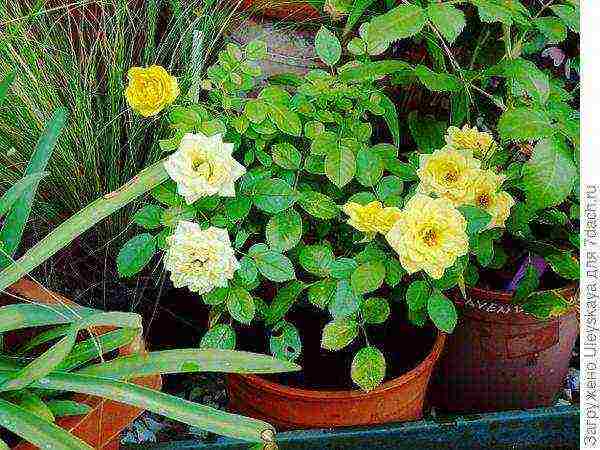
The variety was created by the French company Meilland in 2001. Bushes up to 40 cm high, compact. Leaves are green, leathery. The flowers are large for miniature roses (up to 6 cm in diameter), golden yellow, double. They bloom from the first ten days of May and bloom profusely and for a long time until autumn.
Application This luxurious "golden" miniature variety will look great in borders, it will not get lost on the ridges, in mixborders. In pots and container culture, he will be unmatched!
Miniature rose cultivar 'Lavender Meillandina'
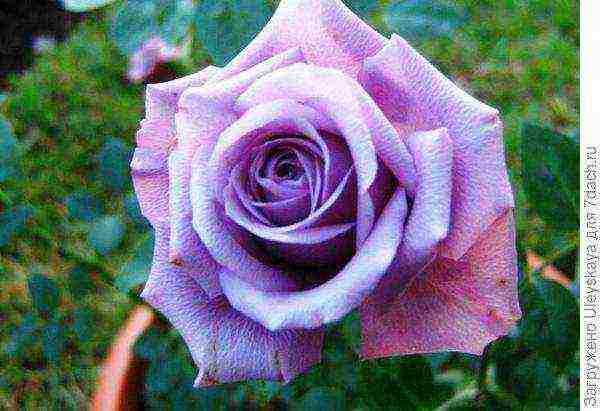
An unusually beautiful variety created by Meiyan in 1999; may be found on sale under the name 'Lavender Sunblaze'. The bush is 40-50 cm high and up to 40 cm wide, densely leafy, almost without thorns. Leaves are dense, leathery. Flowers with a diameter of 4-6 cm, lilac-purple, densely double, slightly fragrant; single or 2-5 in inflorescences. Blooms throughout the summer. In the southern zone of horticulture, the variety is frost-hardy, in central Russia it needs to be covered with spruce branches and snow. Resistant to fungal diseases, but vulnerable to rain.
Application The variety deserves the attention of lovers of lavender color, this color of flowers looks advantageous with various bells against a background of silvery leaves. It can be used in the design of a children's area. Good in mini flower beds, container and pot culture.
Miniature rose cultivar 'Maidy'
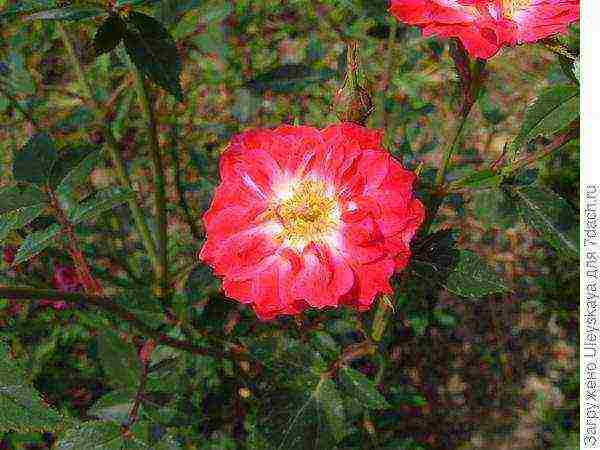
A very interesting bright variety, created by the German company Kordes in 1984. The bush is up to 35 cm high, dense, compact. The leaves are dark green, leathery, shiny. Terry flowers are large, up to 5 cm in diameter, slightly fragrant. The color of pointed petals, neatly folded in the form of a tile, is two-colored: in the center they are white, to the edge they are dark red. Blossom profusely throughout the season. In the southern zone of horticulture it is frost-resistant, in the middle lane we cover it with spruce branches and snow. Medium resistant to powdery mildew, vulnerable to black spot.
Application A fabulous variety for growing in pots, containers, but it fully "reveals" itself in the open field - in solitary (single) or group plantings, on low boles. Doesn't need any addition.
Miniature rose cultivar 'Mandarine Symphonie'

This miniature variety is in tune with music, which, together with flowers, gives joy and good mood. It was created in 2000 by the famous Meilland company, which presented the world with a huge number of beautiful varieties of roses. Bushes are low, compact. The leaves are dark green, small. Terry bright orange (yellow below) flowers of medium size are collected in inflorescences. Bloom for a long time, re-flowering.
Application Effective in groups. You can create bright floral borders from it.
Miniature rose cultivar ‘Mr. Bluebird '
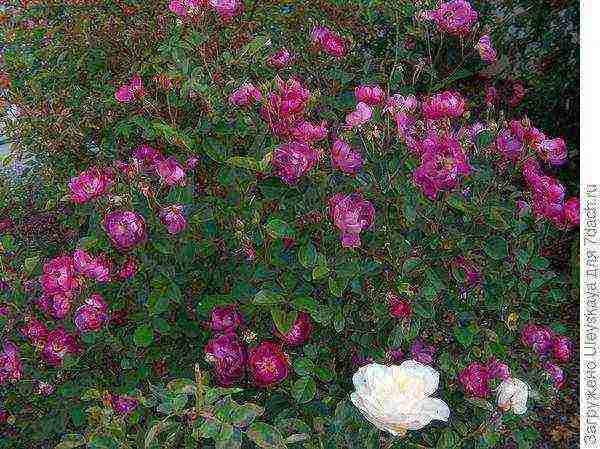
The miniature rose variety under this name is unusual! Like little birds perched on the branches of a bush. The variety was created by the American breeder R. Moore in 1960. The bush is up to 50 cm high, flowers 3-4 cm in diameter, mauve with a white eye in the center, semi-double, without aroma, collected 7-15 per inflorescence. Blossom during the summer and into late autumn.
Application Suitable for curbs, rabatok, suitable for indoor cultivation.
Miniature rose cultivar 'Rouletii'
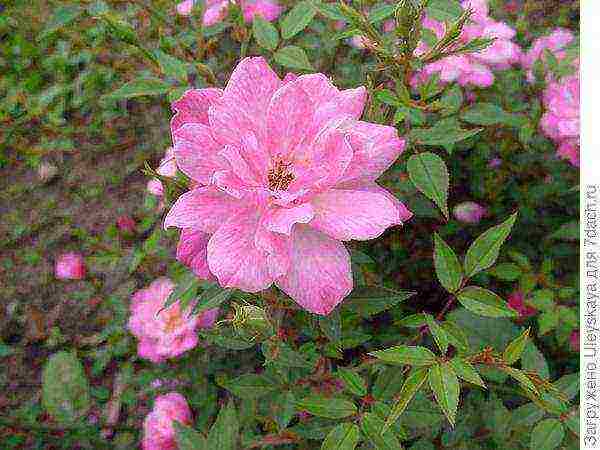
An old variety improved by Roulet in 1920. It can be marketed under other names such as Rosa chinensis var. minima, R. 'Pompon de Paris'. Bushes are erect, 20-40 cm high, 20 cm wide, openwork. The leaves are small, narrow. Semi-double flowers are small, 2-4 cm in diameter, cupped, pinkish-fuchsia (lilac-lavender when flowering), fragrant, collected in inflorescences up to 25 pieces.Blossom abundantly and for a long time (on the southern coast of Crimea - until December). The variety is frost-hardy in the southern zone of horticulture, unpretentious, sometimes affected by powdery mildew.
Application Despite the delicacy, landscape designers love to use this variety in borders, ridges. Some hobbyists plant it on boles, plant it in raised flower beds, and grow it in containers and pots.
Miniature rose cultivar 'Stars'n Stripes'
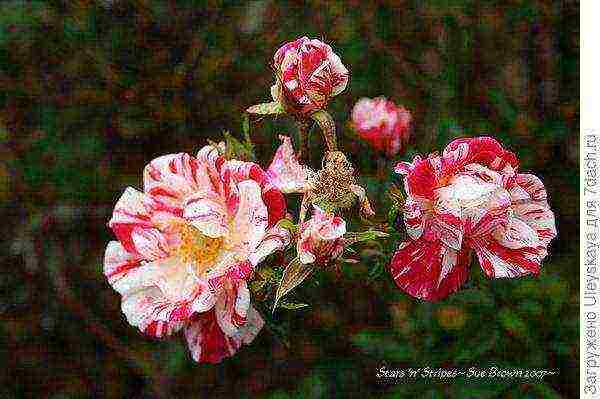
This charming variety was created by R. Moore in 1975. Unequal bush 30-40 cm high, up to 70 cm wide seems more open than upright, shoots without thorns. The leaves are small, dark green. The flowers are goblet, up to 4.5 cm in diameter, in a red-pink strip, semi-double, fragrant, collected on long refined shoots of 3-5 pieces. Blossom from summer to late autumn. Unpretentious, winter-hardy (in central Russia it requires shelter with spruce branches and snow), resistant to fungal diseases. In cool and humid summers, it is sometimes affected by powdery mildew.
Application The variety is as if created for children who, with all their childlike spontaneity, will certainly appreciate it. Suitable for planting in a small children's corner in the country or in a pot on the terrace. Good in small gardens, suitable for growing on low boles, in a pot culture.
Miniature rose ‘Sunmaid’

The name of this variety was given by the originator J. Spek in 1972. The bushes are low, 30-40 cm high, compact, densely leafy. The leaves are dark green, leathery, shiny. Double flowers with a diameter of 2.5-4 cm, bright orange (reddening and turning pink as they bloom), with a delicate aroma, collected in inflorescences of 3-10 pieces. Blossom from summer to autumn (several waves of flowering).
Application Good in borders, ridges, used on boles and in container, pot culture.
Miniature rose variety 'Pomegranate Bracelet'

Domestic variety created by Zinaida Konstantinovna Klimenko in Crimea in 2007. Bushes 30-35 cm high, densely leafy. Leaves are dark green, shiny, toothed, wavy. Densely double flowers are large, up to 7 cm in diameter, two-colored, pink-white, the shape is old, the bud remains half-open. They bloom profusely and tirelessly until late autumn. Winter-hardy in the southern gardening zone. Resistant to fungal diseases
Application An unusually beautiful variety that can be used to create borders, ridges; it will not get lost in the mixborders in the foreground; can be grafted onto low stems and grown in containers and pot culture.
Miniature rose variety 'Boy-with-Finger'
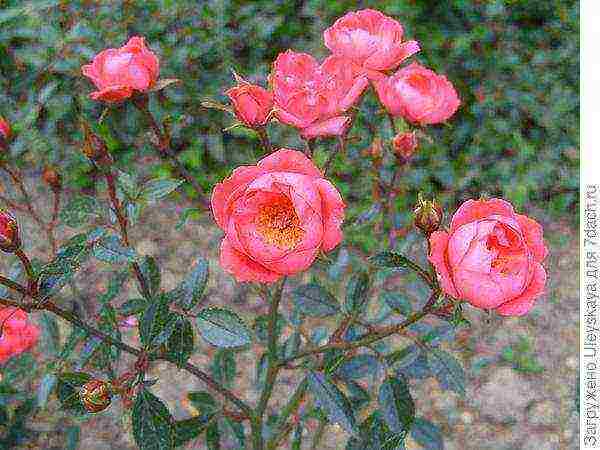
A luxurious domestic variety created by the spouses Konstantin Ivanovich Zykov and Zinaida Konstantinovna Klimenko in 2008. Bushes 30-40 cm high, compact, densely leafy. The leaves are dark green, small, elongated. The flowers are small, up to 4 cm in diameter, red, cupped, semi-double, collected in inflorescences from 3 to 100 pieces, with a delicate aroma. Blossom profusely and for a long time. Winter-hardy in the southern gardening zone.
Application Good in curbs, ridges, on low boles; suitable for container and pot culture.
Miniature rose cultivar 'Zwergkonigin'

The variety was created in Germany by Kordes, whose breeders improved the flower's decorative qualities in 1978, so the variety can be sold under the name 'Zwergkonigin 78'. The bush is 50-60 cm high. The leaves are green, shiny. The flowers are large, with a diameter of 4-5 cm,
red, slightly aromatic, terry; bloom throughout the summer.
Application This miniature bright variety will not be lost anywhere: neither in flower beds, nor in containers, nor in pots.
And what miniature roses grow and bloom in your country house?
The best varieties of miniature roses, photo
From the name alone, it immediately becomes clear that we are talking about the most compact representatives of roses. At the same time, classic miniature roses have not only very modest growth (from 0.3 to 0.5 m), but also small flowers with graceful leaves. However, we are increasingly seeing varieties of the so-called patio roses.This designation of roses is mainly used in England and describes varieties with compact growth, but larger flowers than miniature roses.
In the group of miniature roses and patio roses, there are varieties of a wide variety of flower shades with different abundance of flowering. However, before buying, it is imperative to clarify the resistance to leaf diseases, since old varieties in this regard often lose to modern ones.
 When decorating a garden, miniature roses are naturally suitable for small areas, for example, for the foreground of mixed flower beds or flower beds. Such roses look especially attractive in a rock garden if the soil is deep enough. But really their charm reveals itself when planted in tubs on the terrace and balcony, precisely because of their compact growth. And the roses themselves feel better when grown in tubs, to which they react with the harmonious formation of a bush and abundant flowering. These are re-blooming roses. Depending on the size, several bushes can be planted in one tub at once, but it is important not to forget about good ventilation, since if the foliage is too wet, the risk of leaf disease increases. It is important to stick to the golden mean when watering, as excess water can damage the roses.
When decorating a garden, miniature roses are naturally suitable for small areas, for example, for the foreground of mixed flower beds or flower beds. Such roses look especially attractive in a rock garden if the soil is deep enough. But really their charm reveals itself when planted in tubs on the terrace and balcony, precisely because of their compact growth. And the roses themselves feel better when grown in tubs, to which they react with the harmonious formation of a bush and abundant flowering. These are re-blooming roses. Depending on the size, several bushes can be planted in one tub at once, but it is important not to forget about good ventilation, since if the foliage is too wet, the risk of leaf disease increases. It is important to stick to the golden mean when watering, as excess water can damage the roses.
The most beautiful varieties of miniature roses
Sonnenröshen (Sonnenroscherf)
Kordes (2005), ADR 2003
Miniature ground cover roses, ideal for rock gardens.
Growth features: the bush is wide and low, with cascading shoots, height from 0.2 to 0.3 m.
Flowers: simple non-double, cream, almost like Potentilla, dark yellow stamens.
White Babiflor (White Babyflor)
Tantau (Tan tau 2010)
Small white flowers in clusters, profusely flowering cultivar.
Growth features: compact bush, height from 0.3 to 0.4 m.
Flowers: white, dense double, yellow stamens.
Flirt 2011 (Flirt 2011)
Kordes (2011), ADR 2011
A profusely blooming miniature rose with a high resistance to leaf diseases, suitable for gardens with a small area, for growing in tubs on a terrace or balcony.
Growth features: compact, wide and branched bush, height from 0.4 to 0.5 m.
Flowers: pale pink in a variegated strip with a white underside of the petals, semi-double, in abundant racemes, long lasting.
Medley Pink (Medley Pink)
Noack 2002, ADR 2006
A profusely blooming variety of Patio roses with dark pink, semi-double flowers.
Growth features: compact, branched bush, height from 0.3 to 0.4 m.
Flowers: dark pink, semi-double, in brushes.
Apricot Clementine (Apricot Clementine)
Tantau (2001)
This variety of miniature roses is characterized by dense buds of a noble shape of a delicate apricot-orange hue.
Growth features: compact and strong bush, height from 0.3 to 0.5 m.
Flowers: pink to apricot orange, long lasting.
Little Sunset (Little Sunset)
Kordes (2007)
A very colorful miniature rose with small, noble flowers in abundant clusters. Reminiscent of the famous Gloria Dei in miniature.
Growth features: the bush is wide, dense and compact, branches well, height from 0.3 to 0.4 m.
Flowers: yellow with red edging, small, noble in shape, in abundant racemes.
Mandy
Kordes (2011)
A typical miniature rose with very small flowers and delicate foliage, it is an ideal choice for growing in pots or in flower beds in combination with other plants.
Growth features: the bush is very compact, dense and low, the height is from 0.3 to 0.4 m.
Flowers: blood red, velvet red in bright sun, graceful, double, in abundant racemes.
Medley Ruby (Medley Ruby)
Noack (2012)
Rather typical of Patio roses (very compact height with medium-sized flowers), therefore best suited for growing in pots or small gardens.
Growth features: compact, low, branched and dense bush, height from 0.4 to 0.5 m.
Flowers: ruby red, very colorfast, double, noble shape, in small clusters.
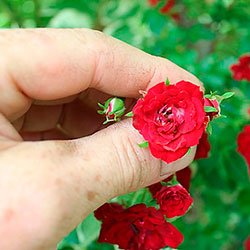 Miniature or dwarf roses have been known in Europe for only a hundred years. These cute looking flowers can beautify any garden. They are grown outdoors in soil or container. The process is simple, but it still contains several important features.
Miniature or dwarf roses have been known in Europe for only a hundred years. These cute looking flowers can beautify any garden. They are grown outdoors in soil or container. The process is simple, but it still contains several important features.
Miniature roses: description and varietal variety
Dwarf, it is the border variety, according to external data, is in no way inferior to classic roses. Characteristics:
- height - 15-20 cm, the maximum of some varieties is up to 50 cm;
- crown - dense, collected from small leaves with a matte surface;
- buds are combined into inflorescences of 3-5 pcs .;
- at the same time, roses of different colors are formed on one plant.
Attention! Interestingly, the blooming of dwarf roses lasts almost the entire season. Activity decreases slightly during the hottest months.
The cultivation of miniature roses is practiced in the following forms:
- in a pot;
- in a portable container in the open air;
- in the open field.
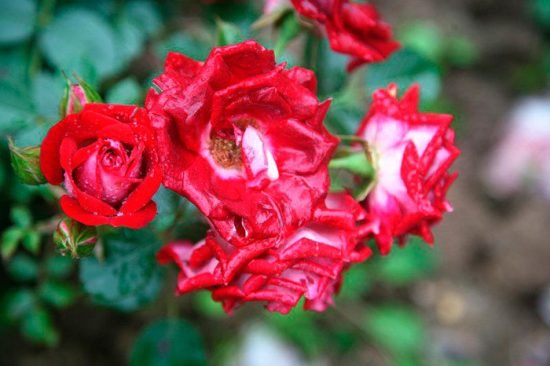
The opinion that designers use small shrubs only when decorating a small area is wrong. Dwarf roses are a full-fledged and independent decorative element of a garden or park landscape.
Attention! When cut, the flowers stay in water for 7-9 days. Some roses have a delicate scent.
Among the most popular varieties:
- Hummingbird. Bush up to 30 cm high with dark leathery leaf plates. The buds of an unusual appearance are about 3 cm in size. The color of the flowers is bright yellow-orange. They tend to burn out.
- Javel. One of the smallest varieties. Its leaves are elongated, leathery. Terry flowers, 3-5 cm in diameter. Color - bright red with yellow underneath. The petals can fade, and the buds can bend under their weight.
- Garnet. The petals of this rose combine shades of red and crimson. Their shape is classical, size - up to 5 cm. The foliage is dense, leathery.
- Lavender. Height - up to 40 cm. Flowers with a diameter of 4-5 cm. In spring they look like a hybrid tea rose, at the height of the season they look like a floribunda. The color is lavender, with the presence of purple inserts.
- Amulet. The 50-centimeter bush blooms with bright pink double flowers. The foliage is dense, green.
Planting curb roses in the open field
Start by selecting a seedling. Signs of a healthy plant:
- the root is not overdried;
- trunk - elastic, dark green;
- there are no stains, mold or damage on the branches.
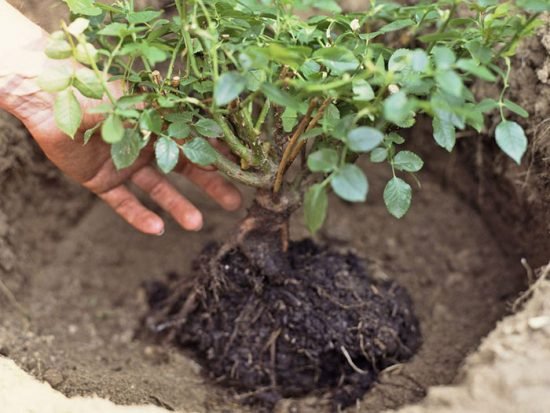
Planting roses in the ground
When the planting material is ready, select a place for it. The shrub loves an abundance of sun or partial shade. Slightly acidic loam is best suited for growing border roses. The soil must be sufficiently fertile. To bring it back to normal:
- clayey raw soils are fed with humus with sand (for digging);
- dry sandy ones, on the contrary, are diluted with clay and humus (2-3 buckets).
Advice. Consider and improve drainage. Especially if rain or melt water stagnates on the site.
Planting such rose bushes should only be done in early spring. For the season before the next winter, the roots will take root and get stronger. Algorithm of work for open ground:
- Soak the root of the seedling in water for 6 hours. If it is long, cut it to 9-10 cm.
- Prepare the landing pits. The depth corresponds to the length of the roots.
- Add 0.4 kg of lime, 0.2 kg of wood ash, 0.2 kg of dolomite flour, 50 g of superphosphate to the planting hole.
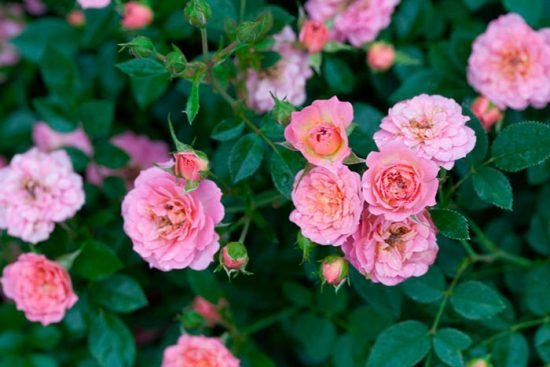
- Fill the hole with water. When it is absorbed, proceed directly to planting.
- Cover the plant immediately with a nonwoven fabric. This measure will help protect the roses from sunlight and frost at first.
Advice. Do not touch or water the bushes for several days after planting.
Culture care
Miniature roses need standard grooming methods. Watering the shrub is required twice a day: in the morning and in the evening. But excess moisture for the roots is destructive. In rainy periods, it is better not to water the bush. Remember to loosen the soil and remove weeds regularly.
A miniature rose does not need serious shelter to successfully winter.She is able to calmly endure frosts in the climate of the middle zone of the Russian Federation. In the fall, carry out the following procedure:
- tear off the remaining buds and flower stalks;
- cover with spruce branches;
- build a wire frame about 20 cm high above the bush;
- place it over the plant;
- cover the frame with insulation;
- put a layer of film on top.
Attention! It is important for the health of the culture that the insulation is not carried out before the establishment of the final frost.
Roses are pruned after winter, immediately following the harvesting of the protective material. Simply remove damaged or frostbitten shoots by cutting at an angle. At least three buds should remain on one shoot. Measures to protect against garden pests of the curb variety are needed the same as for an ordinary rose. After the first leaves and buds grow, spray the bush with Prestige, Antizhuk or another insecticide. Dilute according to the instructions.
Fertilization and reproduction of miniature roses
Experts advise to feed the culture according to the following scheme:
- ammonium nitrate or urea - in early spring after cleaning the shelter;
- the same fertilizer - after 2-3 weeks;
- complex mineral mixtures - after the appearance of the first buds;
- potassium nitrate (superphosphate is possible) - in August.
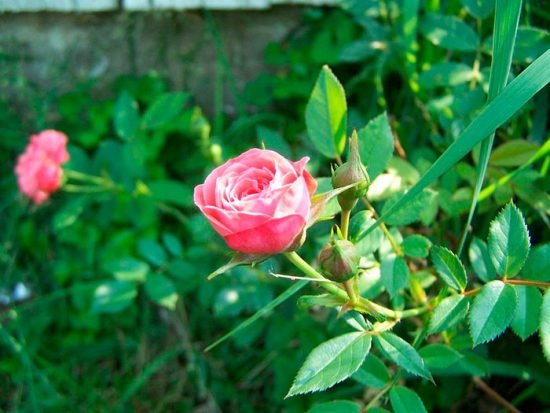
Such a rose is propagated only by cuttings:
- pick up strong shoots with 3-4 buds;
- make a cut at right angles above the upper kidney, at 45 ° at the lower one;
- soak the cuttings in Epin's solution (100g / l) for 8-10 hours;
- prepare the container;
- lay out the drainage, pour in a fertile substrate;
- pour a layer of sand about 1 cm on top;
- root the cuttings, water and cover with foil.
For the twigs to take root, at least 1 month must pass. During this time, occasionally check the soil, not allowing it to dry out. After a month, the cuttings can be ventilated from time to time. Growing a miniature rose is fun and not too difficult. By adhering to the basic guidelines, you will decorate your garden with amazing flowers in different shades.
Miniature rose: video
Miniature roses on video.
Absolutely all varieties of miniature spray roses are a real find for those who do not have the opportunity to break a large mixborder, but really want to decorate their site with a beautiful floristic composition. These small shrubs do not take up much space and, in addition, they perfectly coexist with a variety of types of horticultural crops, perfectly shading tall tapeworms and perfectly complementing ground cover loaches.
Miniature rose is a low, compact plant no more than 25-35 cm high, with small flowers, graceful leaves and thin shoots.
Miniature roses for outdoor cultivation
The concept of miniature roses has changed rapidly over time. A large number of new varieties appeared after breeders of ornamental plants mastered modern breeding techniques. Since about 1980, special attention has been paid to potted roses. As a result, roses growing in a pot, bucket or box on the balcony have completely new uses.
Naturally, new advantages were also applied to the cultivation of miniature roses in the open field. At the same time, the properties of growth, uniformity and density of foliage were improved, the number of flowers and their size were increased. It is also worth noting the significant improvement in the health of roses and the strict differentiation of varieties of miniature roses in accordance with different purposes. Nevertheless, some intersections with a group of low-growing climbing roses could not be avoided.
Miniature roses are also called ground cover roses. Such a double name already in itself testifies to the varied uses of the plants of this group. Initially, miniature varieties were intended to decorate city flower beds.
Previously, they were planted with the ground cover variety Contoneaser. It is quite simple to look after him, but he also looks boring. To remedy the situation, gardeners were looking for an alternative among densely growing, resistant varieties of roses that could turn discreet flower beds into flowering carpets.First, they decided to use old varieties and, among other things, upright, single-flowering varieties with long shoots and the possibility of branching, as well as miniature polyanthus roses with small flowers.
Before long, nurseries provided stores with many new varieties that needed to be grouped. At least in terms of growth properties. Five such groups were formed:
- Slow growing, ground cover;
- Growing upright, with a tough stem;
- Low, with dense foliage;
- Slightly curved, spreading;
- Intensively growing, ground cover.
These photos show miniature roses from different groups:
The name "ground cover roses" is problematic for an amateur gardener. Most often, such a plant is expected to grow at a height of several centimeters from the soil level. However, these varieties behave differently. To avoid misunderstandings, the names "ground cover roses" and "miniature bush roses" were coined. And here we are again where there are no clear distinctions between groups of plants. Several decades ago, many varieties of miniature bush roses could well be ranked among the group of modern climbing roses.
Now check out the description of the ADR miniature rose colors.
The best varieties of miniature roses and their photos
The best miniature shrub roses with the ADR quality mark include:
Sort "Apfelblute" - color from pale pink to white.
Sort "Arcadia" - pink.
Sort "Bonica 82" - light pink color.
Sort "Charmant" - intense pink color.
Variety "Danica" - white.
Sort "Estima" - pink.
Gartnerfreude is a hot pink.
"Hannovers WeifSe" variety - white.
Sort "Heidetraum" - pink-red color.
Variety "Knirps" - carmine pink color.
La Sevillana - purple color.
Variety "Limesglut" - purple color.
Sort "Magic Meidiland" - carmine-pink color.
Sort "Medeo" - white with a pink tinge.
Sort "Medusa" - dark pink color.
Variety "Mirato" - pink.
Sort "Nemo" - white.
Sort "Palmengarten Frankfurt" - carmine-pink-red color.
Sort "Pepita" - bright carmine-pink color.
Variety "Pink Bassino" - pink.
Variety "Pink Meidiland" - pinkish, white in the center.
Pink Roadrunner - bluish-pink color.
Variety "Pink Swany" - carmine-pink color.
Ravenna cultivar - rose red / light pink color.
Sort "Red Yesterday" - carmine-pink color, with a red eye.
Rosa Rugosa "Foxi" variety - carmine pink color.
Saremo variety - light pink color.
Sort "Satina" - light pink color.
Sort "Schneeflocke" - snow-white color.
Sort "Schneekonigin" - white.
Sort "Schneesturm" - creamy white color.
Variety "Smart Roadrunner" - violet-pink color.
Sort "Soft Meidiland" - pink color.
Sommerabend variety - bright red color.
Sommerwind - pure pink color.
Sort "Sonnenroschen" - white with a yellow eye.
Sort "Sunny Rose" - bright yellow / light yellow color.
Sort "Sweet Flaze" - hot pink / light pink color.
Sort "Sweet Meidiland" - pink.
Variety "Venice" - white color.
Variety "White Haze" - snow-white color.
Variety "Wildfang" - pink, light pink.
The most popular varieties of miniature roses are presented in these photos:
Next, you will learn how to prune miniature roses for the winter.
Correct pruning of miniature roses for the winter (with video)
These roses are the smallest. But it is very important to trim them correctly, because if you do not do this, some varieties lose their typical appearance.
Many, in particular the old varieties, have countless weak, thin, branched shoots. It is hardly possible, and besides, it is very difficult to cut them strictly according to the rules. And this is useless! The easiest way is to grab the crown with your hand and cut off all the shoots by half or two-thirds of the length, that is, about ten centimeters.
When pruning miniature roses for the winter, the weakest and lateral shoots can be removed later. This will encourage the growth of strong fresh growth, which will produce fluffy and dense foliage and guarantee the correct shape of the plant.
There are no general rules for pruning miniature spray roses. And all because this group of plants is incredibly diverse in all possible parameters, including the shape and properties of growth. When pruning, the size of the area to be covered with flowers is critical.
This is achieved only through long-term cultivation.Therefore, pruning primarily includes minor corrections and, of course, the removal of dead or diseased shoots. It is not necessary to prune miniature roses in the fall every year. Intensive pruning for the purpose of healing is carried out every 3-5 years.
The ideal number of strong buds on the shoot is 5-6. Keep in mind that among miniature spray roses there are also single-flowering ones. After radical healing pruning, such roses do not bloom the next year.
In large areas, miniature shrub roses can be cut with a brush cutter without fear of harm. If necessary, after rough pruning, the bushes can be trimmed more precisely and thinned out.
Watch how the correct pruning of bush roses is done in this video:



